Rajasthan Board RBSE Class 12 Maths Chapter 8 Application of Derivatives Ex 8.4
Use differential to approximate the following :
[Q. 1 to Q. 11]
Question 1.
(0.009)1/3
Solution:
Let y = x1/3 and x = 0.008
∆x = 0.009 – 0.008 = 0.001
∵ y = x1/3
Diff. w.r.t. x,
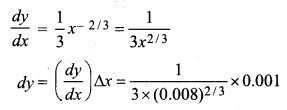
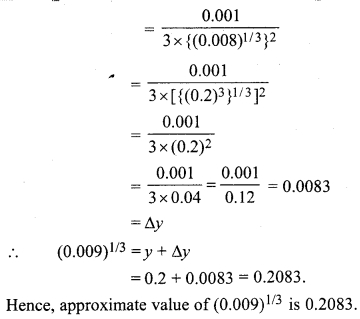
Question 2.
(0.999)1/10
Solution:
Let y = x1/10, x = 1, y = 1
∆x = 0.999 – 1 = -0.001
∵ y = x1/10
Diff. w.r.t. x
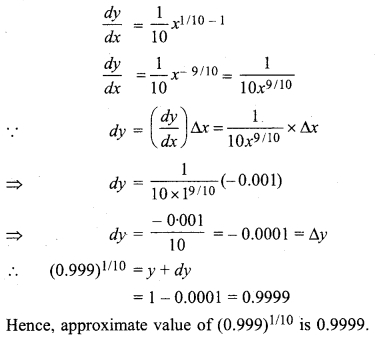
Question 3.
\(\sqrt { 0.0037 }\)
Solution:
Let y = \(\sqrt { x }\), x = 0.0036, y = 0.06
∆x = 0.0037 – 0.0036 = -0.001
∵ y = \(\sqrt { x }\)
Diff. w.r.t. x
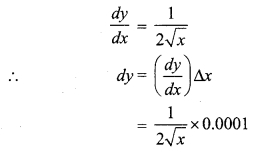
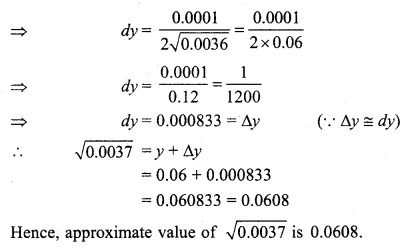
Question 4.
\(\frac { 1 }{ { (2.002) }^{ 2 } } \)
Solution:
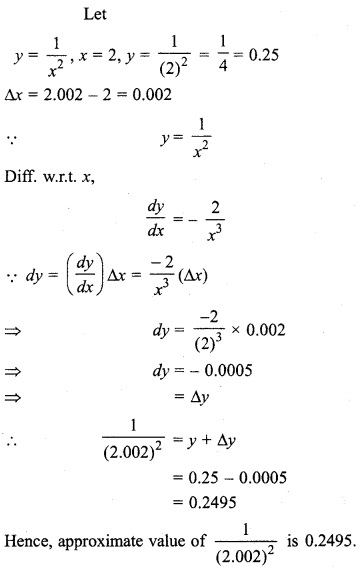
Question 5.
(15)1/4
Solution:
Let y = x1/4
x = 16, y = (16)1/4 = 2
∆x= 15 – 16 = – 1
∵ y = x1/14
Diff. w.r.t. x
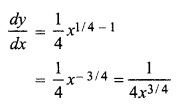
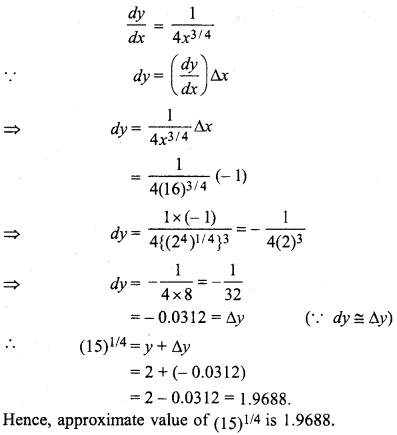
Question 6.
\(\sqrt { 401 }\)
Solution:
Let
y = x1/2, x = 400, y = 20,
∆x = 401 – 400 = 1
∵ y = x1/2
Diff. w.r.t. x
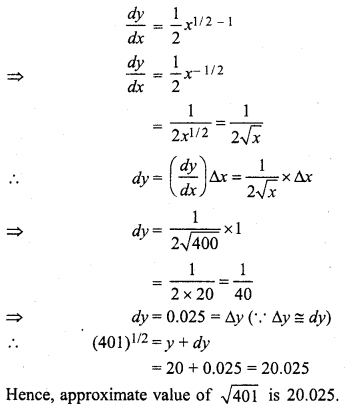
Question 7.
(3.968)3/2
Solution:
Let y = x3/2, x = 4
y = (4)3/2 = (22)3/2 = 23 = 8
∆x = 3.968 – 4 = -0.032
∵ y = x3/2
Diff. w.r.t. x
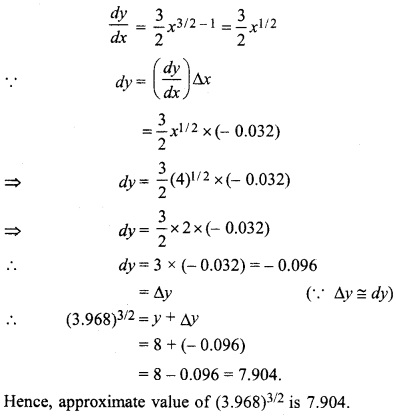
Question 8.
(32.15)1/5
Solution:
Let y = x1/5, x = 32, y = (32)1/5 = 2,
∆x = 32.15 – 32 = 0.15
∵ y = x1/5
Diff. w.r.t. x
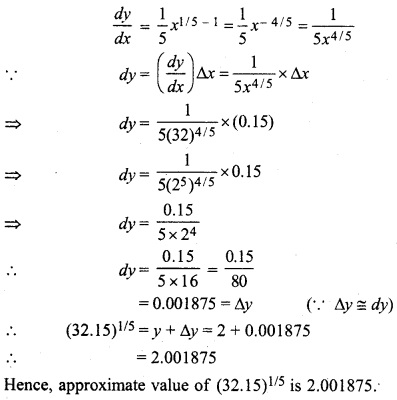
Question 9.
\(\sqrt { 0.6 }\)
Solution:
Let y = \(\sqrt { x }\), x = 0.64, y = 0.8
∆x = 0.6 – 0.64 = -0.04
∵ y = \(\sqrt { x }\)
Diff. w.r.t. x
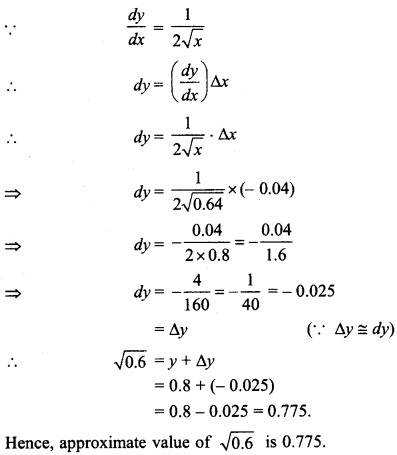
Question 10.
log10 (10.1), when log10 e = 0.4343
Solution:
Let y = log10 x
where x = 10, ∆x = 0.1
⇒ x + ∆x = 10.1
y = log10 x
= log10e. loge x
Diff. w.r.t. x,
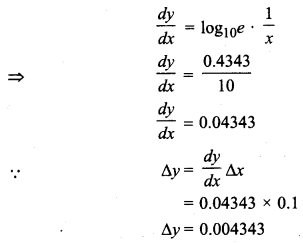
Now, from equation (i)
y + ∆y = log10 (x + ∆x)
⇒ log10 x + ∆y = log10 (x + ∆x)
⇒ log10 10 + 0.004343 = log10 (10.1)
⇒ log10 (10.1)= 1 + 0.004343
log10 (10.1)= 1.004343
Hence, approximate value of log10 (10.1) is 1.004343.
Question 11.
loge (10.02), when loge10 = 2.3026
Solution:
Let y = loge x
Where x = 10, ∆x = 0.02
and x + ∆x = 10.02
∵ y = loge x
Diff. w.r.t. x,
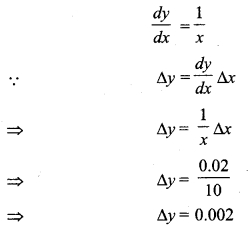
From equation (i),
y + ∆y = loge (x + ∆x)
loge x + ∆y = loge (x + ∆x)
⇒ loge 10 + 0.002 = loge (10.02)
⇒ loge (10.02) = 2.3026 + 0.002
⇒ loge (10.02)= 2.3046
Hence, approximate value of loge (10.02) is 2.3046.
Question 12.
If y = x2 + 4 and x changes from 3 to 3.1, then use differential to approximate change in y.
Solution:
Given, y = x2 + 4
At x = 3
y = (3)2 + 4 = 9 + 4 = 13
∆x = 3.1 – 3 = 0.1
∵ y = x2 + 4
Diff. w.r.t. x,
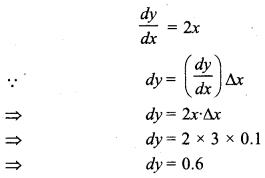
Hence, approximate value of change in y is 0.6.
Question 13.
Show that the relative error in computing the volume of a cubical box, due to an error in measuring the edge, is approximately equal to the three times the relative error in the edge.
Solution:
Let length of edge of cubical box is x and volume is V, then
V = x3
Diff. w.r.t. x,
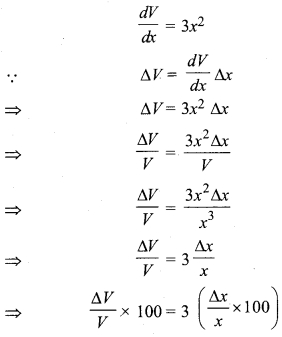
Question 14.
The radius of a sphere shrinks from 10 cm to 9.8 cm. Find approximate decrease in its volume.
Solution:
Given
Radius of sphere = 10 cm
∆r = radius shrinks
= 9.8 – 10
= – 0.2 cm
Volume of sphere, V = \(\frac { 4 }{ 3 } \) πr3
Diff. w.r.t. r,
\(\frac { dV }{ dr } \) = \(\frac { 4 }{ 3 } \) π 3r2 = 4 πr2
∵ Approximation error in calculation of volume of sphere,
dV = \(\frac { dV }{ dr } \) × (∆r)
dV= 4πr2 × (∆r)
⇒ dV= 4π × (10)2 × (- 0.2)
⇒ dV = – 400 × 0.2 π cm3
= -80 π cm3
Hence approximation error in volume is 80 π cm3